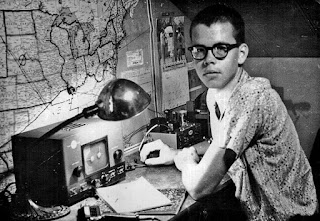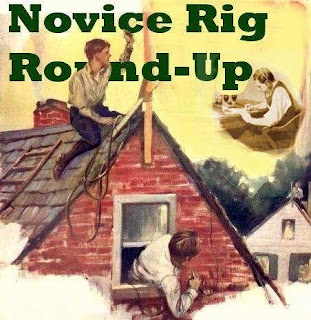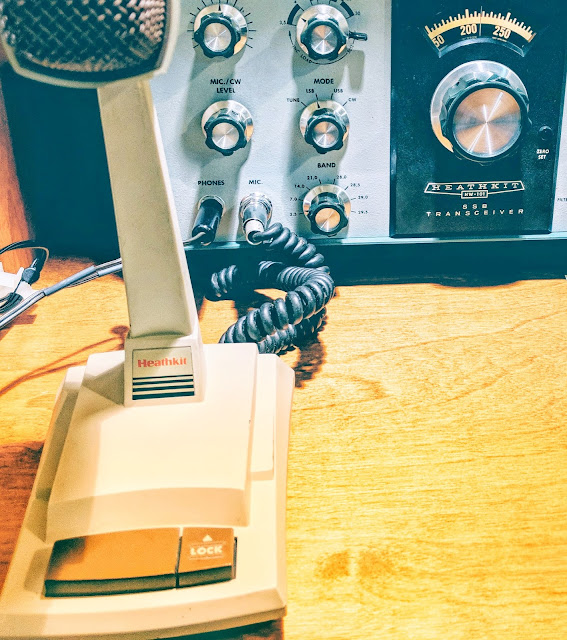 Amateur Radio Weekly – Issue 194
Amateur Radio Weekly – Issue 194
Yaesu FT-817 replacement details leaked
Finally, the replacement for the very successful Yaesu FT-817nd is about to see the light of day.
QRPblog
APRS over HF
HFAPRS with APRS Messenger & DroidPSK.
OH8STN
Send APRS to email via Xastir on RF
You may only send one line messages of 64 total characters maximum for the message.
S55MA Ham Blog
KM4LAO brings Ham Radio hobby, expertise to campus
Willet, who is double majoring in Mechanical Engineering and Engineering Physics, first got licensed in June 2015 as a ham radio operator because of her interest in Morse code.
Kettering University
Build a Milk Crate AM Broadcast Loop Antenna
It’s small enough to maneuver around easily, but big enough to give it some gain, so I can listen to daytime DX.
Shortwave / Medium Wave
Inside the desperate fight to keep old TVs alive
Behind a nondescript Manhattan storefront, Chi-Tien Lui is stockpiling objects many people wouldn’t think twice about trashing: cathode ray tube televisions.
The Verge
1940s transmitter finds new home
The massive transmitter is being moved from the former RCI site to the former Dorchester jail.
CBC
Video
Video over HF
FreeDV plus Video adds a new dimension: A QSO where you’re able to listen to and see the other operator.
WA6NUT
Quartzfest 2018 part 1
Jeri Ellsworth, AI6TK, and Amy Herndon, AI6ZU, at Quartzfest.
K7AGE
A visit to Orlando Hamcation 2018
Hamcation video highlights.
Retro Tech & Electronics
Amateur Radio Weekly is curated by Cale Mooth K4HCK. Sign up free to receive ham radio's most relevant news, projects, technology and events by e-mail each week at http://www.hamweekly.com.
 A Personal Self Defense Weapon, a Utility Hammer, and a DMR #Hamradio, All-in-One
A Personal Self Defense Weapon, a Utility Hammer, and a DMR #Hamradio, All-in-One
My first impression of my new TYT MD-380 (and Steve, KA4RSZ, felt the same way), was the solid, sturdy feel of the thing. Not at all what you’d expect from an $88 plastic cased electronic device of any sort. We were both quite impressed, and the reason has become clearer as I’ve learned more. This radio or its kin, were built for non-ham, heavy-duty use by folks like security guards and retail store personnel, not dainty and refined hams such as ourselves.
Reading the User’s Manual has been fun, and incidentally makes the bizarre Icom manuals seem lucid. Filled with handy tips, I love where it cautions me on page one “Do not transmit too long, for the radio may heat and hurt the user.” Also advising “if the radio appears smelly or smoke, please shut off…” Great tips for us all.
On page six it is reassuring to be told “wearing the radio in your waist will not make you feel uncomfortable.” I just love Chinglish!
Signing off for now, de k4wk, www.hamdon.com. Thanks for listening; you’re in the log.
Wayne Robertson, K4WK, is a regular contributor to AmateurRadio.com and writes from Georgia, USA.
 LHS Episode #209: The Weekender III
LHS Episode #209: The Weekender III
 Welcome to another edition of The Weekender. These episodes are designed to give you fun things to do, touch, hear or see for your weekend. It may be food, drink, amateur radio, science, technology, open source or anything at all. But the hope is that it's enjoyable, entertaining and possibly educational. Thanks for listening!
Welcome to another edition of The Weekender. These episodes are designed to give you fun things to do, touch, hear or see for your weekend. It may be food, drink, amateur radio, science, technology, open source or anything at all. But the hope is that it's enjoyable, entertaining and possibly educational. Thanks for listening!
73 de The LHS Crew
Russ Woodman, K5TUX, co-hosts the Linux in the Ham Shack podcast which is available for download in both MP3 and OGG audio format. Contact him at russ@bluecows.com.
 February at Potter Place
February at Potter Place
Dave K1SWL, Tim W3ATB and I met for lunch and then went to operate at the old rail station in Potter Place. I worked 8 stations including Belgium, Portugal, Spain and France.
I set up the KX3 under the eaves of the station on an old luggage box. I tossed my antenna line over the semaphore signals attached to the station. (See the last photo.) The place was covered with snow, and it was 43F.
I started off working Joe W1FYL at a campsite in Kissimmee, Florida. We had a nice chat then I tuned down the band. The DX was surprising. Here’s my log:
15 Feb-18 1818 14.043 W1FYL CW 599 599 FL
15 Feb-18 1859 14.008 ON4UN CW 579 599 Belgium
15 Feb-18 1902 14.010 CS0RCL CW 599 599 Portugal
15 Feb-18 1903 14.012 EA8URT CW 599 599 Spain
15 Feb-18 1905 14.022 EA5KV CW 599 599 Spain
15 Feb-18 1914 10.112 F5NTV CW 599 599 France
15 Feb-18 1915 10.116 N2CX CW 579 559 NJ
Meanwhile Tim had tangled his line in a maple tree above the picnic table across from the station. His water bottle dangled from a branch just out of our reach. It was a three stooges movie in progress as we struggled to retrieve the bottle. We borrowed a garbage can from the station and turned it upside down. Dave had a shovel in the back of his truck and Tim (standing on the upside-down garbage can) managed to snag the errant bottle with the shovel. But not before previous efforts failed with me sitting on his shoulders. (Fortunately not captured on camera.)
Tim and Dave worked half a dozen stations including Joe N2CX who was at Fort Mott in New Jersey doing a park activation.
Jim Cluett, W1PID, is a regular contributor to AmateurRadio.com and writes from New Hampshire, USA. Contact him at w1pid@amsat.org.
 The 2018 Novice Rig Roundup (NRR)
The 2018 Novice Rig Roundup (NRR)
One of the most enjoyable operating events of the year is fast approaching -- the Novice Rig Roundup or 'NRR'. Technically, it is a contest, but I have the feeling that most participants think of it as just a lot of fun and a nice opportunity to hear and work some of the great old 'classics' of the past -- rigs that were used when they were teenage Novices or rigs that they could only drool about owning, back in those formative years when they each discovered the magic of radio.
 |
| WN4HQW's '62 Novice station (now N4CF) |
The dates to remember are 0000 UTC March 3 - 2359 UTC March 11 and this multi-day opportunity is, for me, what makes the NRR so enjoyable. With a nice diversion from the usual 'contest frenzy' associated with standard weekend operating events, the NRR can be enjoyed throughout the week, whenever you choose to participate. If last year's operating patterns continue, you should find activity at any time of the day ... and even more as sunset arrives.
With the fast-approaching solar minimum, we will be hard-pressed to relive the glory days of worldwide 15m propagation, as even last year's event proved to be tough on this band. With a little luck and, hopefully, a well-timed solar flare, we may get lucky! If you operate during the daylight hours, please get on 15m and give it a shot ... and be sure to announce your activity on the NRR's sked and chat page here, so that others will know where to find you, especially if you are rock bound in true Novice fashion. With our present spotty conditions, we need all the help we can get and the sked page proved a very valuable asset during last year's affair.
Although technically not required, if you plan to participate it's best to obtain your own NRR number, which is an easy 30-second process.
Additionally, there is an online logger where participants can post their daily log. The nifty logger also keeps track and figures out your score as it goes and no 'after contest' log needs to be submitted. If you plan on submitting a log, the logger is a requirement. The logger will also require you to set up a 'log-in' and once again, a simple 30-second process will take care of that from here.

Stations may run either crystal-control or VFO or can switch between either method ... the online logger will keep track and score things appropriately. Stations running in both Novice 1 and Novice 2 categories (probably most common), will be eligible for prizes in both modes if they make at least ten contacts using a Novice 1 station or if they work ten Novice 1 category stations.
All of the rules and information can be found on the NRR's excellent website. As well, the soapbox comments and station pictures from last year's NRR may provide the inspiration that you need to spark-up your own activity in this year's event ... from what I can tell, this year will be bigger and busier than ever!
There is also a dedicated NRR Yahoo Group, often the source of much valuable discussion.
Last year I ran my homebrew Longfeller in the (now eliminated) QRP category, and had a ton of fun. You can read about it here. This year, I have refurbished a nice Drake 2NT that had been gathering dust in the basement for over 25 years ... it's all ready to go now, but a problem with the VF-1 VFO has arisen. The combination works well on 40m and above but on 80 it's a different story. The VFO runs on 160m and it seems that the 2NT balks at the idea of doubling in the buffer stage to 80m. Unless I solve the problem, I'll be rockbound on 3579, 3550 or 3560kc. ... it was 'kilocycles' back then, which always seemed to make more sense to me than 'kilohertz'.
If you have access to the web while operating, be sure to bookmark and check-in to the NRR's realtime chat page. Many ops that are crystal controlled will announce their operating frequencies, making it easier for you to find them ... sometimes way up or down from the normal NRR watering holes of ~ 3550 - 3650 kHz, 7100 -7125 kHz, 21.100 - 21.150 MHz and 28.114, 28.120 MHz ... and don't forget to check the colorburst crystal frequency of 3579!
Of course with the large number of rockbound stations (on crystals), be sure to look above and below these frequencies. It's good practice to listen well above and below your own frequency as well, for anyone answering your CQ who may be up or down the band on crystal control. Unlike today, this was very common practice back in the Novice days!
 |
| courtesy: Harry - VE7AIJ |
You still have time to get that old clunker on the air but if that's not possible, you can join the fun with your modern rig as well ... all are welcome to jump in and have a great week of radio-fun. I think you will be surprised, just as I was last year, how good some of these old classics can sound ... and you'll hear some great bug-fists as well.
As indicated on the NRR website, this is "more of an EVENT than just a typical contest ... once again taking our OLD ham radios off the shelf and putting them to use again! "
See you in the 2018 NRR!
Steve McDonald, VE7SL, is a regular contributor to AmateurRadio.com and writes from British Columbia, Canada. Contact him at ve7sl@shaw.ca.
 The dark side
The dark side
Oh my, what have I done
Richard Carpenter, AA4OO, is a regular contributor to AmateurRadio.com and writes from North Carolina, USA. Contact him at aa4oo@hamradioqrp.com.
 Let’s Call CQ – QSO Today Episode 184 with NW7US
Let’s Call CQ – QSO Today Episode 184 with NW7US
I got a Skype call a few weeks ago from Eric, 4Z1UG–the creator and host of the QSO Today Podcast–during which he asked me about how and why I got into amateur radio. Here’s the result.
Eric writes,
We talk a lot about the band conditions due to the Sunspot cycle. Most of it on Facebook and other places is about how “dead” the bands are at this point. We all can’t wait until the cycle starts to rise and we will be making contacts with little effort. I remember in my conversation with Chuck Adams, K7QO in Episode 58, that he really enjoys operating is “Pigrig”, one watt, CW transceiver on 20 meters. When I asked him, (I liberally paraphrase) “but Chuck, the bands are dead. How does that work for you?”. His reply was that while most hams are listening to the bands, he calls CQ until he gets a reply. Works every time.
My QSO this week is with Tomas Hood, NW7US, who has years of expertise in propagation and Solar activity. He is the propagation editor of more than a few radio magazines and websites. In our post-recording conversation we discussed this phenomenon of listening and not calling CQ. I even had this idea that maybe one of the reasons that the digital modes are so successful is because they “beacon”, as part of the whole digital experience, the same as calling CQ. This is why they make contacts. From what I see, looking at PSK Reporter, hams are making lots of contacts worldwide using the digital modes. While SSB may not be working so well, CW and the digital modes seem to work fine.
I like to work on my bench or make the podcast while listening to the bands. Jeff Damm, WA7MLH, in Episode 177, says that he will put his keyer in CQ mode while he is working on a new radio. Invariably, sometimes after many minutes, he gets a reply. Great idea Jeff!
73,
Eric, 4Z1UG
Episode 184 can be found here: https://www.qsotoday.com/podcasts/nw7us
Highlights of Episode 184:
Tomas Hood, NW7US is the propagation editor of a number of shortwave and amateur radio magazines, and has a wide variety of websites, that grew out of his love for all things radio, and for listening on the bands to far off DX and commercial broadcast stations. Tomas shares his understanding of propagation and the lessons we can learn from listening, really listening to the QSOs and exchanges during contest operation.
All of the QSO Today episodes are great. I enjoy hearing about many different hams. Do check out all of the episodes that Eric has published.
73 de NW7US dit dit
Visit, subscribe: NW7US Radio Communications and Propagation YouTube Channel



















